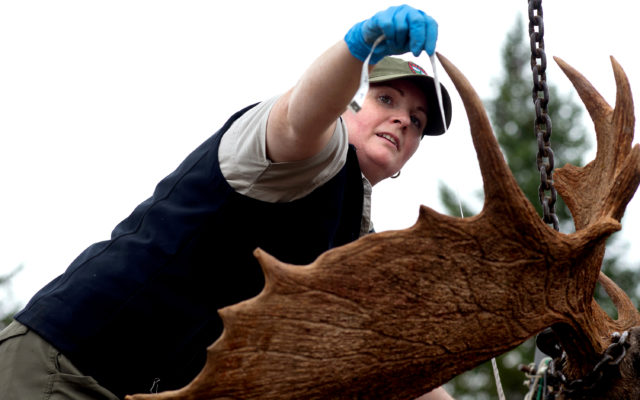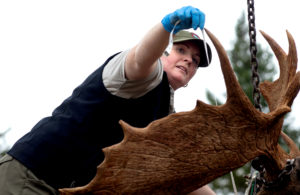
81 percent of hunters in first moose season filled their tags
This year’s moose seasons are bucking traditional wisdom, according to the state’s moose biologist, who said he was a bit surprised that 81 percent of hunters in the first six-day season, which was staged two weeks ago, filled their tags during a hot week of hunting.
The general rule: Cool weather favors the hunter, while warm weather makes the moose less likely to show themselves as they seek darker, cooler places and avoid moving around.
“[That total] is significantly high, in that at least the first three days of the hunt were way above normal temperatures,” said Lee Kantar, moose biologist for the Maine Department of Inland Fisheries and Wildlife. “I was in Fort Kent [on Tuesday] of that week and it was 83 degrees. For the first five hours of the day I never stopped checking moose.”

Bangor Daily News photo/Linda Coan O’Kresik
Amanda Demusz, wildlife biologist, Maine Department of Inland Fisheries and Wildlife, measures the spread of antlers on a moose at the tagging station at Gateway Variety in Ashland on opening day of the 2020 Maine moose hunt.
By noon on Tuesday, Sept. 29, the Fort Kent tagging station had registered 55 moose, he said, including one that weighed in at a whopping 1,031 pounds.
“I would have expected very few moose to come in because of the temperature and the way people are and the way moose are, but we were just hand over fist [busy],” he said.
The biologist said good winter survival likely helped boost the moose herd in that area, which had plenty of moose to begin with.
According to the department’s online big game registration dashboard, 778 of the 955 hunters who held permits for the Sept. 28 to Oct. 3 hunt were successful. In 2019, over all seasons 69 percent of hunters filled their tags.
Kantar said that on Monday, the opening day of the second six-day season, near perfect hunting conditions had not translated into hunter success at the Jackman tagging station he was monitoring.
“I would say things are slower than expected given today is probably perfect conditions,” Kantar said. As of 2 p.m., just 11 moose had been tagged at Bishop’s Store.
“It was just below freezing this morning and a beautiful day, with a nice little wind,” Kantar said. “It’s hard to say what people are doing, whether they’re calling or riding roads. But people have seen a pile of moose.”
It’s not uncommon for hunters to hold out on shooting smaller moose early in the week, hoping to cross paths with a large bull that they can take.
For hunters looking to fill their tags during this second season, Kantar said paying close attention to the cues the moose are providing will be key.
“It’s too early to say whether there are any moose responding to a cow call … if you can locate a bull and a cow [together], you’re trying to challenge the bull at that point, so you’re resorting more to bull calls and raking tactics at that point,” Kantar said.
“Raking” involves the hunter thrashing nearby bushes with a branch or other object to simulate the sign of a bull moose marking its territory with its antlers.
The state allotted 3,135 moose permits that are spread over four hunting seasons this fall.
This year’s moose season breakdown:
— Sept. 28-Oct. 3: 955 bull-only permits allotted for 11 Wildlife Management Districts.
— Oct. 12-17: 1,395 bull-only permits allotted for 18 Wildlife Management Districts.
— Oct. 26-31: 745 cow-only permits allotted for 6 Wildlife Management Districts.
— Nov. 2-28 (including Oct. 31 for Maine residents): 40 any-moose permits allotted for 2 Wildlife Management Districts.